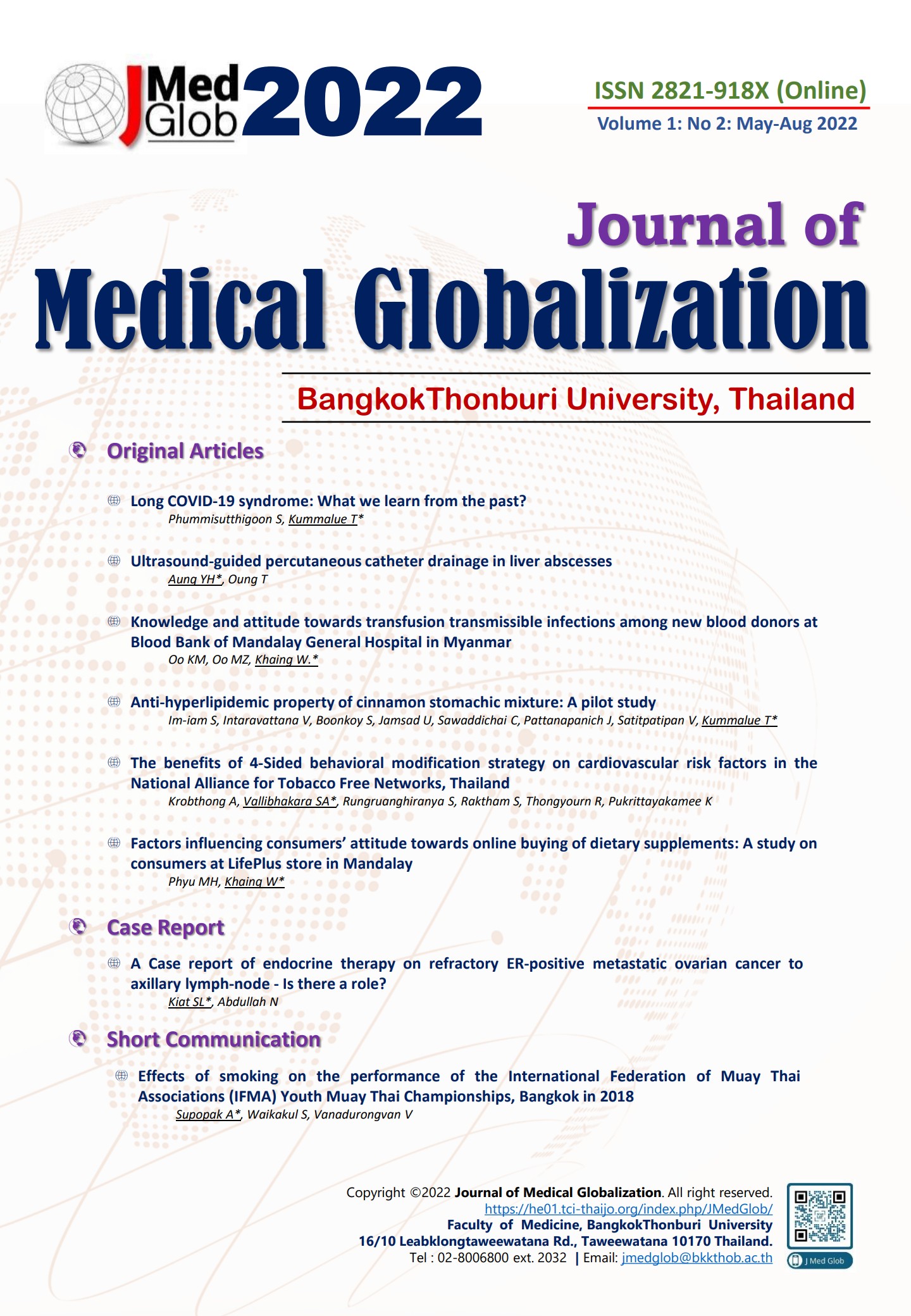Ultrasound-guided Percutaneous Catheter Drainage in Liver Abscesses
Keywords:
Liver abscess, PCD Percutaneous catheter drainage, Pigtail catheter, Ultrasound-guidedAbstract
Objectives: To study the outcome and effectiveness of ultrasound-guided percutaneous catheter drainage in liver abscess.
Materials and Methods: This prospective study was conducted from 2017 to 2018. A total of 33 patients with liver abscess were treated with this method. Ultrasound and CT abdomen were done after clinical assessment for the initial size and localization of the abscess cavity. The percutaneous drainage with a 12-Fr pigtail catheter was done with the “trocar and cannula” method. Then, the cavity size was assessed every 2 days by the ultrasound. After removal of the catheter, the patients were assessed with ultrasound at the 2nd and 4th weeks. Hospital stay, cavity size reduction, and outcomes were studied.
Results: The study showed that patients were mainly aged between 31 and 40 (21.2%). Most patients were males (78.8%). In this study, amoebic abscess patients started to gain a 50% reduction in abscess cavity size after drainage at 4–28 days (11.45 days±7.46) whereas pyogenic abscess patients started at 6–28 days (12 days±10.71). The amoebic liver abscess group showed 2–9 days of hospital stay (4.45 days±1.79). Patients with pyogenic abscess had 3-6 days of hospital stay (4.75 days±1.5). One patient experienced localized peritonitis (3.4%) and 1 patient encountered a blocked catheter (3.4%).
Conclusion: This study highlighted Myanmar's clinical data of liver abscess and the results and outcomes of the percutaneous catheter drainage method for liver abscess treatment. Although this was a small sample size study, this method showed rapid improvement and good clinical outcomes.
References
Singh S, Chaudhary P, Saxena N, Khandelwal S, Poddar DD, Biswal UC. Treatment of liver abscess: prospective randomized comparison of catheter drainage and needle aspiration. Ann Gastroenterol. 2013;26(4):332-339.
Rajak CL, Gupta S, Jain S, Chawla Y, Gulati M, Suri S. Percutaneous treatment of liver abscesses: needle aspiration versus catheter drainage. AJR Am J Roentgenol. 1998 Apr;170(4):1035-9.
Satiani B, Davidson ED. Hepatic abscesses: improvement in mortality with early diagnosis and treatment. Am J Surg. 1978 May;135(5):647-50.
Huang CJ, Pitt HA, Lipsett PA, Osterman FA Jr, Lillemoe KD, Cameron JL, Zuidema GD. Pyogenic hepatic abscess. Changing trends over 42 years. Ann Surg. 1996 May;223(5):600-7.
Wong KP. Percutaneous drainage of pyogenic liver abscesses. World J Surg. 1990 Jul-Aug;14(4):492-7.
Kyaw WA. Comparative study of percutaneous catheter drainage and needle aspiration in the treatment of liver abscess [dissertation]. University of Medicine, Mandalay; 2004.
Win K. The outcome of ultrasound-guided indwelling catheter drainage of liver abscess [dissertation]. University of Medicine (1) Yangon; 2004.
Cai YL, Xiong XZ, Lu J, Cheng Y, Yang C, Lin YX, et al. Percutaneous needle aspiration versus catheter drainage in the management of liver abscess: a systematic review and meta-analysis. HPB (Oxford). 2015 Mar;17(3); 195-201.
Daniel, Wayne W., and Chad Lee Cross. Biostatistics: A Foundation for Analysis in the Health Sciences. Tenth edition. Hoboken, NJ: Wiley, 2013.
Klink CD, Binnebösel M, Schmeding M, van Dam RM, Dejong CH, Junge K, et al. Video-assisted hepatic abscess debridement. HPB (Oxford). 2015 Aug;17(8):732-5.
Giorgio A, Tarantino L, Mariniello N, Francica G, Scala E, Amoroso P, et al. Pyogenic liver abscesses: 13 years of experience in percutaneous needle aspiration with US guidance. Radiology. 1995 Apr;195(1):122-4.
Ralls PW, Quinn MF, Boswell WD Jr, Colletti PM, Radin DR, Halls J. Patterns of resolution in successfully treated hepatic amebic abscess: sonographic evaluation. Radiology. 1983 Nov;149(2):541-3.
Sumit K, Duttaroy D, Ghodgaonkar P, Maru S. Percutaneous Catheter Drainage of Liver Abscesses. Indian J Surg. 2002; 64(6): 516-9.
Bertel CK, van Heerden JA, Sheedy PF 2nd. Treatment of pyogenic hepatic abscesses. Surgical vs percutaneous drainage. Arch Surg. 1986 May;121(5):554-8.
vanSonnenberg E, Mueller PR, Schiffman HR, Ferrucci JT Jr, Casola G, Simeone JF, et al. Intrahepatic amebic abscesses: indications for and results of percutaneous catheter drainage. Radiology. 1985 Sep;156(3):631-5.
Published
How to Cite
Issue
Section
License
Copyright (c) 2022 Journal of Medical Globalization

This work is licensed under a Creative Commons Attribution-NonCommercial 4.0 International License.








